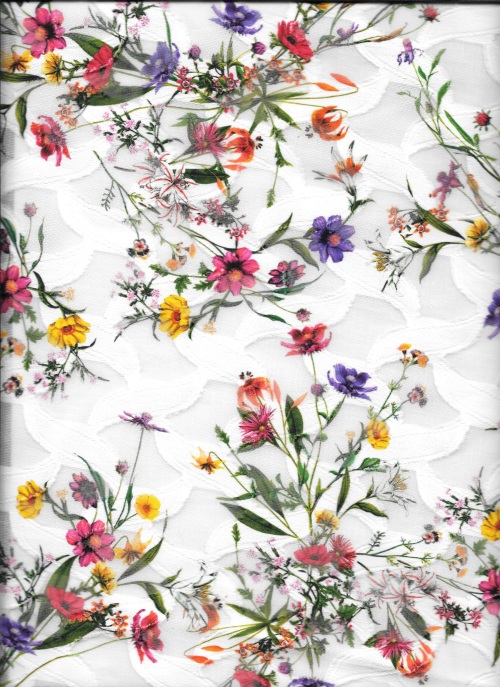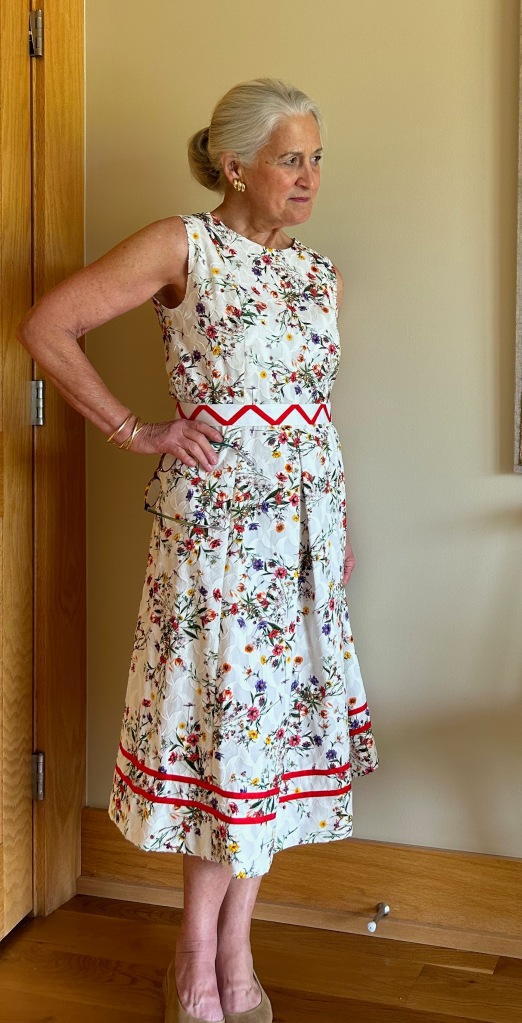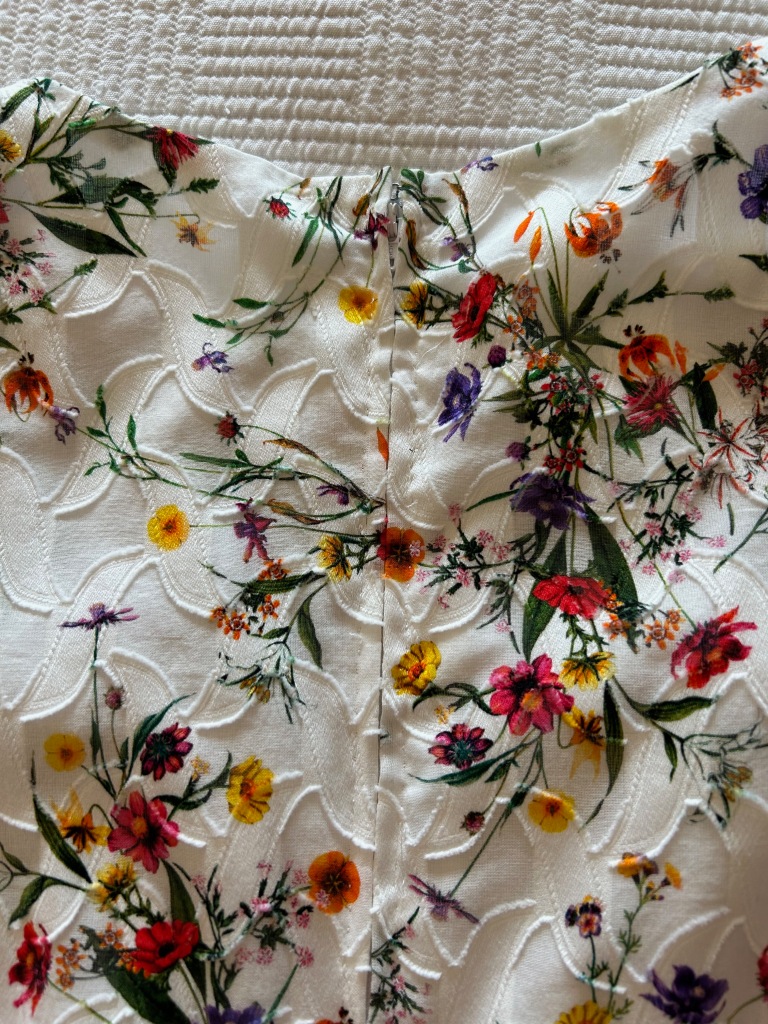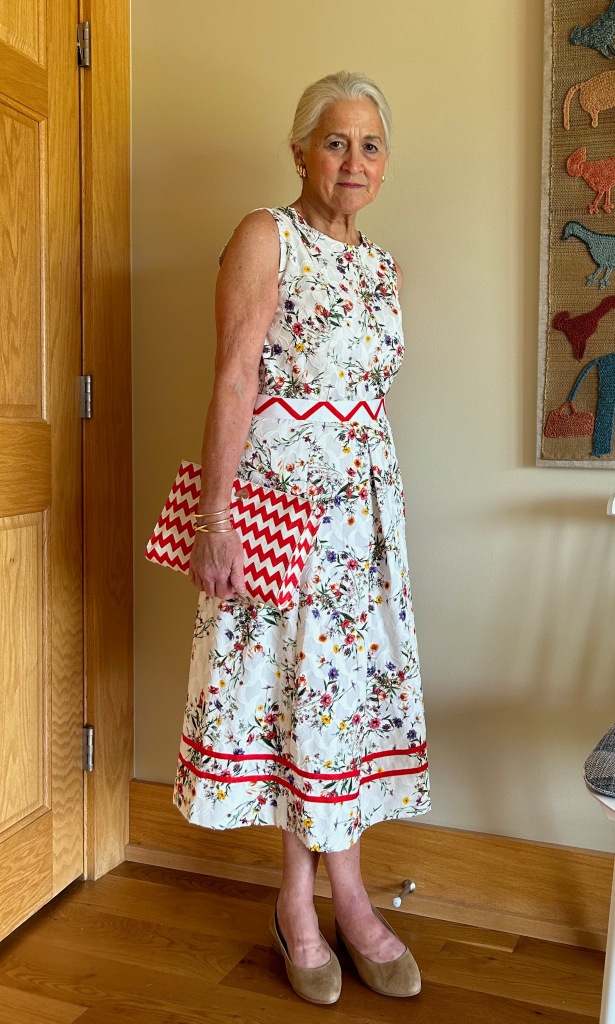For a number of years this light, filmy, patterned and printed cotton, made in Italy, had been lurking in my “cottons basket.” I had purchased two yards of it from Mendel Goldberg Fabrics, for a “future” dress presumably.

At 60” wide, I knew two yards would be sufficient for just about any summer style I chose to make. It seemed like every Spring I would take it out and consider the possibilities for it, not reaching a decision. But this Spring, the “future” had finally arrived, at least for this fabric.
I’m not sure how I came up with the idea to trim it with a coordinating tape/ribbon, but I liked the definition it gave to the colors in the printed floral sprays. First, I thought purple would be a great color to pair with it, then I went to yellow, then to pink. None of those seemed to make the fabric pop the way I anticipated they would. So, even though red is not a dominant color in the print, I decided to try it. And that was it – it worked!
I had already decided on a Vogue pattern I had previously used twice, albeit with a number of obvious changes.
The first construction decision facing me was whether to underline it with cotton batiste and then also line it with – I wasn’t sure what; or just line it and hope that would be sufficient. I wanted to preserve the light, airy feel of the fabric, but I also needed to address the sheerness of part of the fabric.
After much thought and experimentation, I went with using only a simple cotton batiste lining. That turned out to be the right decision. I under-stitched around the inside of the neckline and armscyes even though I did not have an underlining upon which to secure those stitches. However, the under-stitching – which caught only the seam allowance – still had enough of a stabilizing effect to secure those edges.
A hand-picked zipper is always a lovely detail to add to a dress like this:
I’m getting ahead of myself here, but to make this dress, I was eking out small snippets of sewing time during a complicated Spring. And when the time came to do our annual Summer migration from Pennsylvania to Wyoming, 2200 driving miles west, the dress was unfinished.
So, I packed it up along with a lot of other sewing-related things, and I eventually picked up where I left off. I remembered to bring the zipper for the dress, – and the red Petersham ribbon for its embellishment – but I forgot to bring the extra dress fabric. Why was this a big deal, you might be asking? Well – I needed to make a belt for the dress, and my intention was to make a self-belt, edged with the red ribbon.
Once again in my sewing life, I found myself going to Plan B – necessary, if I had any thought of wearing this dress this summer. (Plan B stands for “It BETTER work.”) I hemmed and hawed and decided there were two options. One was a white belt and the other was a red belt. I came to the conclusion a red belt would be too overpowering for the delicate nature of the fabric. So that left me with a white belt, which wasn’t too exciting. Then I had a eureka moment when I realized I could pick up the somewhat zigzag overlay motif in the fabric and embellish the belt with my extra red Petersham ribbon, applied in a zigzag pattern.

So – I rather like the Plan B belt although I may decide at some point to make a self-belt as I had originally intended. We shall see. One thing I know I will do is make belt loops for this dress from its remaining fabric sleeping back in Pennsylvania.
In the meantime, this is a good dress for a hot American summer.
Ciao!




































































































Diversionary Tactics
While bogged down in the fitting of these wool slacks, my mind has been thinking about capes instead.
I know myself well enough to recognize it is always prudent to work on the least favorable item first and save the ”goodies” for later, and that is what I have done with this cape and slacks ensemble introduced in my last post. There is a reason I have made few pairs of slacks in my years of sewing: I find fitting them tedious. So, while I think I am just about satisfied with how they are coming along, the thing which has kept me sane is the prospect of making that beautiful cape.
All of this has led me to do a little research into capes. I started with Fairchild’s Dictionary of Fashion, as I often do when investigating a sewing/fashion topic. Well, oh my! There happen to be no fewer than 8 pages of entries for capes, cloaks, and shawls! It turns out a cape is not just a cape, and the history of capes is long indeed. For my purposes here, the simple definition of a cape is sufficient: “Sleeveless outerwear of various lengths usually opening in center front; cut in a full circle, in a segment of a circle, or on the straight – usually with slits for arms. A classic type of outerwear worn in one form or another throughout history….” (The Fairchild Dictionary of Fashion, Third Edition, by Charlotte Mankey Calasibetta and Phyllis Tortora, Fairchild Publications, Inc., New York, New York, c2003)
Interestingly, Christian Dior has no entry for capes in his Little Dictionary of Fashion, another one of my go-to reference books. But as luck would have it, the newest J. Peterman Company catalogue, Owners Manual No. 197, Holidays 2021, arrived in my mailbox this week. And there on page 5, he has offered for sale a Plaid Wool Cape, with the enticing caption: “Capes are mysterious. Alluring. Functional. In the past, they’ve existed as an alternative to coats so you wouldn’t crush your real clothing…” He goes on to say one will not want to take off this particular cape, as there could be nothing better under it. Well, I guess that’s an arguable point, but you get the picture. Capes demand attention, but in a good way.
I started thinking about the patterns I have gathered over the years, and I remembered at least two which feature capes. Once I got into my pattern collection, I found four besides the one I am currently using.
The earliest one is clearly this Vogue Couturier Design from the second half of the 1950s.
Its description reads: “Suit and Reversible Cape. Easy fitting jacket with concealed side pockets buttons below shaped collar. Below elbow length sleeves. Slim skirt joined to shaped waistband. Reversible, collarless cape has arm openings in side front seams.” I think this is pretty spectacular, and while the suit is lovely, it is enhanced many times over by the addition of the short cape.
Next is this Advance pattern from the 1960s, a cape in two lengths.
I was attracted to this pattern because of its lengthwise darts, its rolled collar and back neckline darts.
The 1970s is represented by the Molyneux pattern I am using and two more: a Pucci design and a Sybil Connolly design.
I purchased the Pucci pattern for the dress (which I now believe to be too “youthful” for me), but its cape certainly completes the outfit. The description reads: “…Cape with jewel neckline has arm openings in side front seams; back vent [which I find interesting}. Top-stitch trim.”
And the final cape pattern I own – almost a capelet – is this Sybil Connolly design. The caption states “…Short asymmetrical flared cape has side button closing.” No arm slits in this cape.
I actually made this cape a number of years ago, but I must admit I have worn it infrequently. The wide stance of the neckline makes it a little unstable. I guess there is a good reason most capes have a tighter neckline – and open in the center front.
So there is my whirlwind cape tour. What do you think? Are capes alluring and mysterious? Functional and sophisticated? I, for one, think capes have a slightly romantic charm to them. Do you?
17 Comments
Filed under Advance vintage patterns, Capes, Fashion commentary, Mid-Century style, Uncategorized, vintage Vogue Designer patterns, vintage Vogue patterns from the 1950s, vintage Vogue patterns from the 1970s
Tagged as capes, fashion sewing, vintage fashion, vintage Vogue patterns